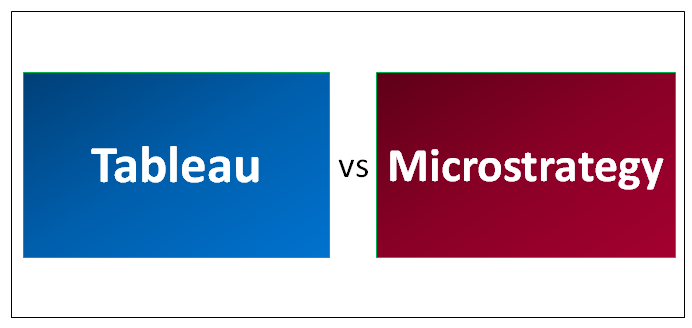Updated May 5, 2023

Differences Between Tableau vs Microstrategy
Tableau is a data visualization tool that helps create appealing charts, reports, and dashboards that are easy to share and interactive. Tableau has unique graphics options to present data in a meaningful manner. MicroStrategy is a data visualization tool. This tool is known for its flexibility and speed of data study without losing on enterprise analytics’ scalability and security. The company follows the motto “Take analytics into your own hand” regarding their data visualization tool. Tableau and Microstrategy are both competitive data visualization tools with their strengths.
Head-to-Head Comparison Between Tableau vs Microstrategy (Infographics)
Below are the top 5 comparisons between Tableau vs Microstrategy:

Key Differences Between Tableau vs Microstrategy
Below are the most important differences Between Tableau vs Microstrategy:
- Tableau Data Visualization tool is among the first of its kind compared to the Microstrategy data visualization tool, which is relatively new.
- Tableau outshines Microstrategy in product capabilities like Collaboration and social BI, Interactive Visual Exploration, Analytics dashboards, Ease of use to deploy and administer, Ease of use to content authors, Ease of use to content consumers in publishing analytic content, embedding analytical content, in embedded advanced analytics, Cloud BI and BI platform administration. Microstrategy is better than Tableau regarding Mobile Exploration and Authoring, Self-Contained Extraction, Transformation & Loading (ETL) & Data Storage, Governance and metadata management, security, and user administration.
- According to Gartner, the tableau is ahead of Microstrategy in Evaluation and contracting, Ease of Deployment, Service, and support.
Tableau vs Microstrategy Comparison Table
Below are the lists of points that describe the comparisons Between Tableau vs Microstrategy:
| Basis For Comparison | Tableau | Microstrategy |
| Tool Description | Tableau is a data visualization tool to create visually appealing charts, reports, and interactive and easy to share dashboards. Tableau is the first of its kind, offering unique graphics options to present data meaningfully. | The Microstrategy data visualization tool is just one of the products that the company has to offer. The company follows the motto “Take analytics into your own hand” regarding their data visualization tool. The tool vouches for flexibility and speed of data study without losing on the scalability and security an enterprise analytics environment offers. |
| Usage |
|
|
| Unique Features |
|
|
| Prerequisites for Usage | For using software:
For installing the software:
|
For using software:
|
| Tool Users | Business Analysts, IT developers, and administrators. | Business Analysts, IT developers, and administrators. |
Conclusion
Having compared and discussed the Differences Between Tableau and Microstrategy, we can come to a partial conclusion that though both the tools have different strengths of their own and are both very good, it is Tableau that is the preferred tool amongst the users due to the factors discussed in the comparison and differences. Even if not required at work, learning and using a data visualization tool in your work area opens up a completely different angle of analyzing, exploring, and presenting data. According to a survey on Data Science and Machine Learning by Kaggle, most find it nice to have a data visualization skill, followed by those who find it necessary. Very few find it unnecessary. The employees of the industries of Technology, Academic, financial, and manufacturing find it essential to learn a data visualization tool. Also, most employees said they used Tableau in almost all their analyses.
Recommended Articles
This has been a guide to the differences between Tableau vs Microstrategy. Here we have discussed Tableau vs Microstrategy head-to-head comparison, key differences, infographics, and comparison table. You may also look at the following articles to learn more –

